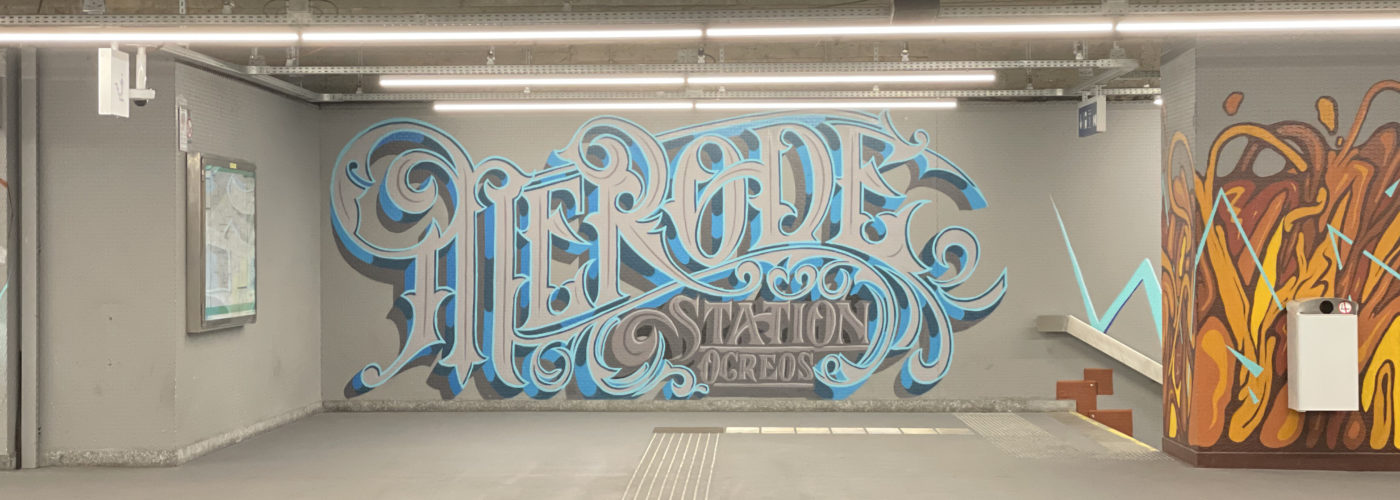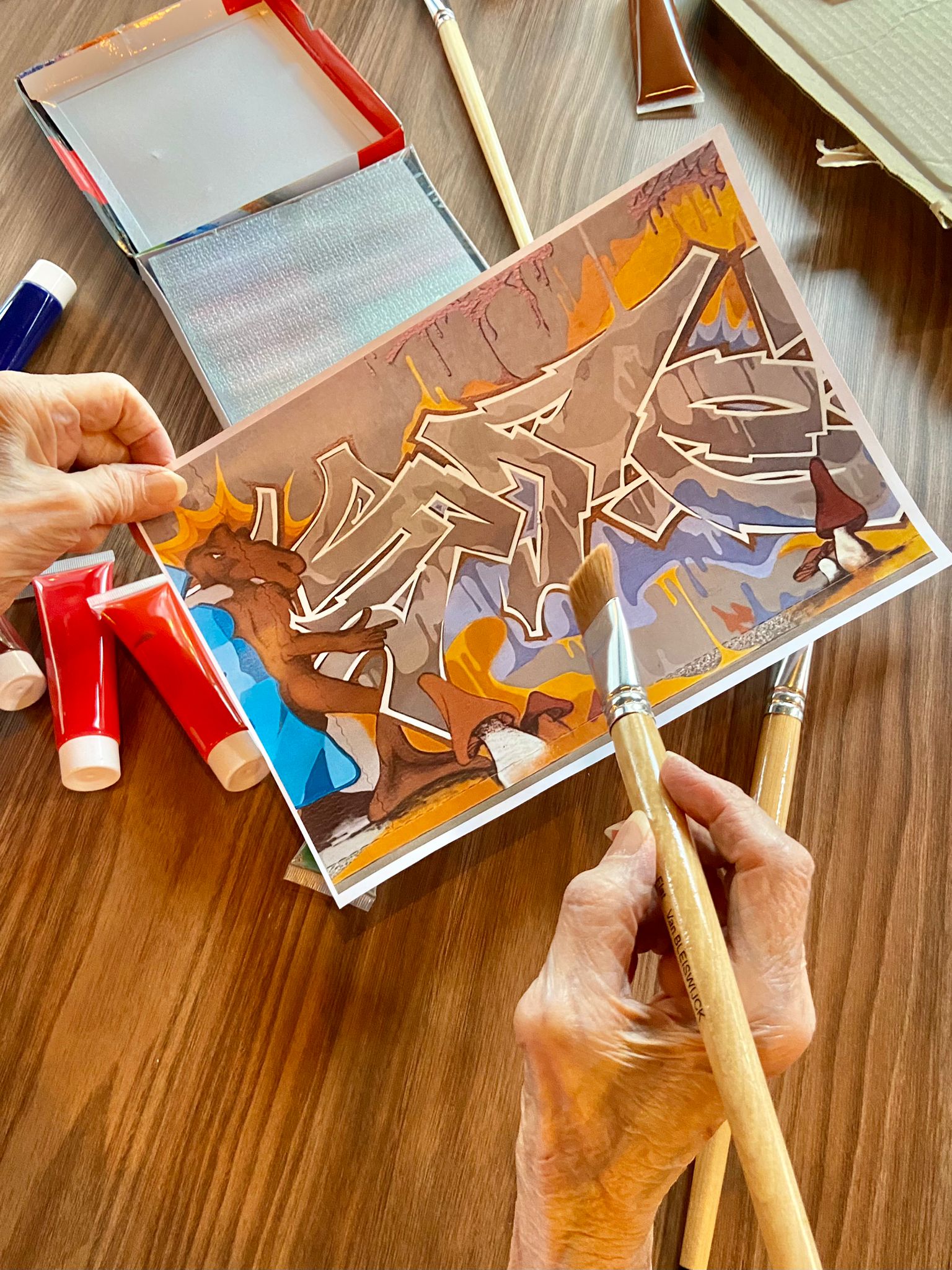The Laboratoire: culture and the medias serving inclusion

Article author :
Eliciting an encounter between teenagers and elderly people around a work of street art, getting them to discuss the role of the media and of culture, then jointly design a collaborative fresco and create a video and a podcast: such is the ‘little’ challenge Emilie Vervust has set herself, with her 1km2 project.
1km2 is the flagship experiment of the Laboratoire, a new Brussels non-profit association created at the beginning of 2023, whose goal is to encourage the inclusion of all and sundry in the medias. A return visit to this out-of-the-ordinary project, where smartphones and FaceApp filters are found alongside walking frames and notepads, where the experiment operates at an interval of 75 years, and where Telegram is simultaneously both this and that.

Equality and diversity in the media, stereotypes which are difficult to shake off
The trigger for the project was an observation: the lack of representation of certain sectors of the population within the media, and the inequalities, stereotypes and discriminations which may arise as a result.
As various studies have proven, significant imbalances still remain between the position certain groups occupy in society and their representation in the media. According to the recent CSA equality and diversity Barometer, women, for example, whilst forming 51.7% of the Belgian population, only represent 39.3% of on-screen contributors. The same is true for people with ethnically diverse backgrounds (32.7% of society against 11.3% in the media), and also people with disabilities (6% against … 0.47%). Apart from a numerical under-representation, the media roles associated with these groups raise a question: women are for example more likely to be assigned roles as witnesses than experts, whilst the opinions of people with disabilities are almost always only solicited when it comes to discussing their condition, etc.
Repeated over and over, these practices not only lead to invisibilising entire fringes of the population, but also contribute, in the collective imaginary, to their being assigned certain roles, locking already discriminated against people into stereotypes which are very difficult to shake off.
1 km2, a cultural experiment rooted in a neighbourhood
It was to respond to this problematic and to contribute to more egalitarian medias that Emilie Vervust created the Laboratoire. The non-profit association’s mission can be summed up in a few words: to valorise the opinions of people rendered invisible in the media, through experiment and exchange, via ‘media experiments.’
Granted, this description may appear somewhat theoretical for someone who is not an expert in these matters. The first of these experiments, 1km2 , is nevertheless firmly anchored in the concrete. It began a few weeks ago in Brussels, and is well worth making the journey.
The project was rolled out on the scale of a neighbourhood, in this case Woluwé-Saint-Pierre, over a period of six months. Pupils from a year-six secondary education class met some fifteen or so residents from a retirement home very close by. Together, they discovered a cultural project situated in the vicinity, more specifically the street art fresco at the SNCB station, Mérode, produced by the Propaganza collective.

For this first edition, the sectors of the community involved were not chosen randomly: the over 65s and the under 19s are in fact the people the least represented in the media. In numerical terms, these two groups make up merely 20% of the contributors whilst they represent over 40% of the population.
‘I came to realise that many of the teenagers and the residents start from the principle that what they think doesn’t count, that they have no role to play in society,’ Emilie points out. ‘The aim of the project is to give value to their opinions, by placing them at the heart of action and practice.’
Practice is indeed precisely the point. Regularly meeting once a fortnight, the participants have developed a shared project: the creation of a collaborative fresco within the premises of the school the pupils attend. Within this context, the two groups meet artists, journalists and film directors, who introduce them to a variety of techniques which are then experimented with jointly. At the end of the project, the pupils will also produce a ‘media souvenir’ of the experience, in the form of a podcast and a video. Tangible productions, therefore, which prove to be an excellent vector of exchange, discovery and learning. A way also of reconciling these sectors of the community with the media, and of placing their opinions and experience at the centre of artistic creations.

Experimentation and exchange at the heart of the project
In this context, lectures on art and how to use a smartphone are absolutely not the way forward: at the Laboratoire, what is involved is creating, testing, getting hands-on with the materials. The participants have discussions, observe and come face-to-face with other viewpoints. A shrewd blend enabling those taking part to get to grips with media and art tools, which are Emilie’s main areas of interest, but also, and above all, to discover the other and to deconstruct prejudices. ‘The aim of the project is not to turn all of the pupils into journalists and for the residents to become experts in street art. The key aspect of 1km2 is to open minds, create bridges, and enable people to have their voices heard by emerging from the terms of reference society has imposed on them.’

Enthusiastic initial feedback
As the project is still ongoing, it is still too early to draw up a comprehensive report of it, in particular in terms of creation and the appropriation of media tools, which will be the focus of the second part of the project. Nevertheless, it is clear that up until now it all seems to be coming together, delivering several surprising results, both touching and quirky. What will stick in the mind will be, amongst others, an initial intergenerational experimenting with digital tools and the hysterical giggles triggered by the use of well-known apps designed to make people look older or younger than they actually are, the unheard of two-person teams which were formed, the caustic wit of several participants, and the interesting opinions concerning the role of art in the city, which transcend the generations.
A special shout-out goes to Christiane L, a resident brimming with charisma, who has her heart set on tagging one of the walls of the retirement home, and who, at the end of one session, says goodbye to the pupils with a: ’Go on, till next time, see you again, Inch’Allah!’ With a wink to Inès, aged 14, who had explained the meaning of the expression to her a few minutes earlier.
More generally, whilst several generation gaps obviously remain, respect and the opportunity to speak prevail, a vital aspect for sectors of the community who do not always feel heard and consequently feel they lack the legitimacy to express themselves. Enthusiasm shines through for both the pupils, happy to get out of a school environment which doesn’t always thrill them, and for the residents, involved in unfamiliar projects. ‘Some families have called us after the workshops to thank us,’ points out Lisa Wilmot, an occupational therapist at the retirement home. ‘It’s the type of reaction which confirms to us that the project has meaning.’

And what’s next?
Whilst 1km2 is currently a pilot project, the aim is to expand it across the whole of Brussels. Emilie intends to develop it further starting from next year, in the process of widening the spectrum of the community sectors involved: ‘We will go with 3 editions in 2024, on a scale of three different neighbourhoods. Two of them will once again bring together teenagers and elderly people, whilst a third will involve new sections of the population, like a school for deaf and hard-of-hearing pupils, or a migration centre.’
Besides such one-off projects, the aim of the Laboratoire is also, over time, to bring together around them a community dedicated to culture and inclusive media. A civic expression platform is in particular being developed, with the mission of becoming one of the non-profit association’s central projects: ‘It will be a website which will take the form of an interactive map of Brussels, on which will be broadcast the Laboratoire’s creations, such as the videos and podcasts produced within the context of 1km2 , but also portraits, testimonies, etc.’ This platform, initially a showcase for the project, will become a media in and of itself within a few years, becoming in concrete terms a vehicle for the opinions of the sectors of the community concerned.
There is also taking seed the idea of developing a physical site dedicated to the inclusive culture of Brussels, which will include experimentation, exchange and broadcasting spaces, offering yet more invitations to communities to encounter one another and express themselves, which the ongoing projects have already successfully initiated.
Long live the Laboratoire
What is striking about this project, is its embedded aspect: in a neighbourhood, in the people, in its praxis. A project with hitherto unseen outcomes, which proves the extent to which experimentation and the meeting of worlds on the face of it distant from one another act as a catalyst for reflections, the creation of small gems, and for gradually instiling more confidence, in oneself and in the other, in one’s voice and in one’s opinion.
We are impatiently waiting to discover its future developments.
More information about the Laboratoire on Facebook, Instagram and LinkedIn
A story, projects or an idea to share?
Suggest your content on kingkong.





